Do you have a question about the Sony ICF-SW77 and is the answer not in the manual?
Details the superheterodyne circuits used for FM and AM reception.
Lists frequency coverage for different models and types of reception.
Specifies the IF frequencies for FM and AM bands.
Describes the types of antennas used for FM/SW and MW/LW.
Outlines power sources and AC adaptor specifications.
Provides estimates for battery operational duration.
Explains tuning stations via preset memory.
Details tuning by directly inputting frequencies.
Describes tuning using the dial.
Explains automatic station searching.
Lists additional functionalities like clock and timer.
Instructions for repairing the microcomputer board.
Procedures for testing the microcomputer board.
Step-by-step guide for replacing the LCD.
Explains how frequency coverage is adjusted via soldering.
Identifies and explains all controls on the unit.
Details battery, AC adapter, and car battery power options.
Guide on setting local and UTC time.
Advice for improving radio signal reception.
How to tune stations using preset memory.
How to tune stations by direct frequency input.
How to tune stations using the dial.
How to scan for stations automatically.
Steps to save and manage station presets.
How to use the automatic shut-off timer.
Guide for programming timer functions.
Instructions for connecting external antennas.
How to record radio programs to a tape recorder.
Procedure for adjusting the main VCO frequency.
Procedure for adjusting the sub VCO freerun frequency.
Procedure for adjusting the crystal oscillator.
Procedure for adjusting the AM first IF stage.
Procedure for adjusting the AM 455kHz IF stage.
Details pin functions for IC801.
Provides a high-level block diagram of the unit.
Details the microcomputer section.
Shows printed wiring board layouts.
Schematic for the microcomputer section.
Schematic for the signal section.
Printed wiring boards for the signal section.
Explains time differences for global reception.
Guide on using the world map for time checks.
Advice for improving radio signal reception.
Explains how to lock the controls.
Guide to tuning using saved station names.
Steps to select stations from Tuning Pages.
Steps to select stations from Quick Pages.
Step-by-step guide for direct frequency tuning.
Tips for adjusting antenna for better reception.
Step-by-step guide for manual tuning.
Adjusting WIDE/NARROW settings.
Instructions for using synchronous detection.
Instructions for SSB reception.
Explanation of synchronous detection benefits.
Steps for automatic station scanning.
Guide to saving station data.
Steps to delete saved stations or frequencies.
How to add multiple frequencies to a station.
How to use the automatic shut-off timer.
How to use auto-tune with station presets.
Guide for programming timer functions.
How to cancel timer reservations.
Explains timer program priority.
How sleep timer interacts with regular timers.
Guide for using the SW compact antenna.
Guide for connecting external antennas.
Methods for connecting antennas for LW/MW/SW.
How to record using a timer with a cassette recorder.
Procedure for adjusting the main VCO frequency.
Procedure for adjusting the sub VCO freerun frequency.
Details pin functions for IC801.
Provides a high-level block diagram of the unit.
Details the microcomputer section.
Details the superheterodyne circuits used for FM and AM reception.
Lists frequency coverage for different models and types of reception.
Specifies the IF frequencies for FM and AM bands.
Describes the types of antennas used for FM/SW and MW/LW.
Outlines power sources and AC adaptor specifications.
Provides estimates for battery operational duration.
Explains tuning stations via preset memory.
Details tuning by directly inputting frequencies.
Describes tuning using the dial.
Explains automatic station searching.
Lists additional functionalities like clock and timer.
Instructions for repairing the microcomputer board.
Procedures for testing the microcomputer board.
Step-by-step guide for replacing the LCD.
Explains how frequency coverage is adjusted via soldering.
Identifies and explains all controls on the unit.
Details battery, AC adapter, and car battery power options.
Guide on setting local and UTC time.
Advice for improving radio signal reception.
How to tune stations using preset memory.
How to tune stations by direct frequency input.
How to tune stations using the dial.
How to scan for stations automatically.
Steps to save and manage station presets.
How to use the automatic shut-off timer.
Guide for programming timer functions.
Instructions for connecting external antennas.
How to record radio programs to a tape recorder.
Procedure for adjusting the main VCO frequency.
Procedure for adjusting the sub VCO freerun frequency.
Procedure for adjusting the crystal oscillator.
Procedure for adjusting the AM first IF stage.
Procedure for adjusting the AM 455kHz IF stage.
Details pin functions for IC801.
Provides a high-level block diagram of the unit.
Details the microcomputer section.
Shows printed wiring board layouts.
Schematic for the microcomputer section.
Schematic for the signal section.
Printed wiring boards for the signal section.
Explains time differences for global reception.
Guide on using the world map for time checks.
Advice for improving radio signal reception.
Explains how to lock the controls.
Guide to tuning using saved station names.
Steps to select stations from Tuning Pages.
Steps to select stations from Quick Pages.
Step-by-step guide for direct frequency tuning.
Tips for adjusting antenna for better reception.
Step-by-step guide for manual tuning.
Adjusting WIDE/NARROW settings.
Instructions for using synchronous detection.
Instructions for SSB reception.
Explanation of synchronous detection benefits.
Steps for automatic station scanning.
Guide to saving station data.
Steps to delete saved stations or frequencies.
How to add multiple frequencies to a station.
How to use the automatic shut-off timer.
How to use auto-tune with station presets.
Guide for programming timer functions.
How to cancel timer reservations.
Explains timer program priority.
How sleep timer interacts with regular timers.
Guide for using the SW compact antenna.
Guide for connecting external antennas.
Methods for connecting antennas for LW/MW/SW.
How to record using a timer with a cassette recorder.
Procedure for adjusting the main VCO frequency.
Procedure for adjusting the sub VCO freerun frequency.
Details pin functions for IC801.
Provides a high-level block diagram of the unit.
Details the microcomputer section.
| FM signal circuitry | Superheterodyne |
|---|---|
| AM signal circuitry | Dual Conversion Superheterodyne |
| FM frequency range | 76.5-108 MHz |
|---|---|
| LW/MW/SW frequency range | 150-29999 kHz |
| LW/AM antenna | Built-in Ferrite Bar Antenna |
|---|---|
| SW/FM antenna | Telescoping Antenna |
| External antenna input | Yes |
| Stereo headphone output | Stereo Mini jack |
|---|---|
| Recording output | Mini jack |
| Speaker size | 4" (10cm) |
| DC power requirement | 6V |
|---|---|
| Battery type | C Batteries x 4 (optional) |
| AC power requirement | 120V, 60Hz with AC Adaptor, supplied |
| FM reception battery life | 45 hours |
|---|---|
| AM reception battery life | 32 hours |
| Dimensions (WHD) | 10 [7]⁄8" x 6 [13]⁄16" x 1 [13]⁄16" (276 x 172.5 x 46.5mm) |
|---|---|
| Weight with batteries | 3 lbs 4 oz (1.48kg) |
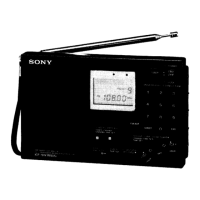
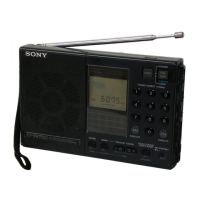
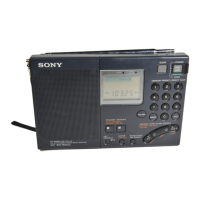
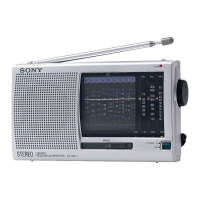
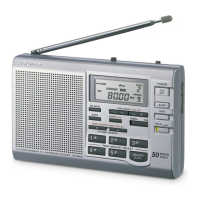
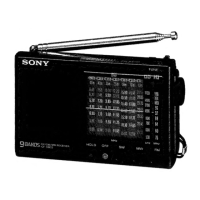


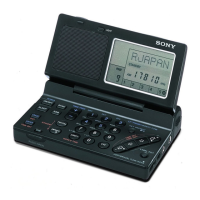
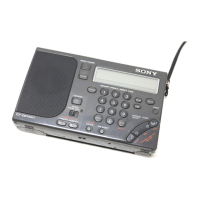

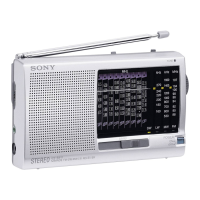
